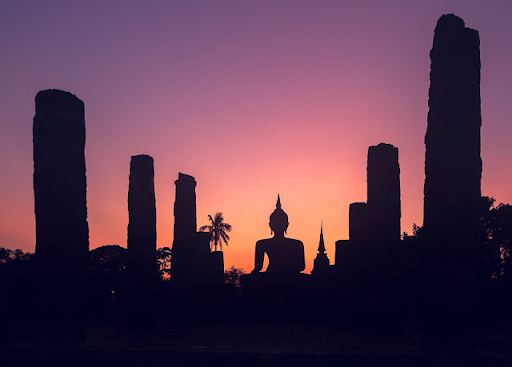The Beginnings of Mahayana Buddhism...

Mahayana Buddhism Takes Form: Anyone Can Become a Buddha
Sasaki Shizuka - From its beginnings in India some 2,500 years ago, Buddhism spread and became influential across a wide area of the subcontinent and Central Asia. The decision of King Ashoka, the third-century ruler of the Maurya dynasty, to become a Buddhist was a pivotal event in the early history of the religion. It is thought that Buddhist teachings were known throughout India and had expanded as far south as Sri Lanka around this time.
In Sri Lanka, the religion has survived a turbulent history, and remains today more or less in the original form in which it was first brought to the island all those centuries ago. From Sri Lanka, the teachings of Buddhism reached Southeast Asia, where Buddhism continues to be a vital part of daily life in many countries to this day. The Theravada Buddhism (the name means “the school of the elders”) practiced in Sri Lanka and Southeast Asia today remains close to the original Buddhism that took shape in the years after the religion was founded.
Around 500 years after the death of Shakyamuni, however, a new variety of Buddhism started to gather adherents in northwest India. This new version of the faith, which espoused dramatically different doctrines from the original teachings of the Buddha, spread from India along the Silk Road into China. Collectively, these new teachings are known as Mahayana (or “the greater vehicle”) Buddhism.
What are the main characteristics of Mahayana Buddhism? In its original form, Buddhism taught that by joining the sangha and becoming a monk, a person could follow a rigorous set of meditative and spiritual practices and eventually attained enlightenment and release from suffering as a disciple of the Buddha. Buddhist disciples and practitioners who achieved enlightenment in this way were known as arhats (Sanskrit) or arahants (Pali). These were regarded as admirable, praiseworthy figures who had achieved the same enlightenment as Shakyamuni—but they were not believed to have the same deep compassion as the Buddha or the same profound understanding of the universe, and were not revered in the same way. They were holy men, but remained disciples of the Buddha. In its original form, Buddhism taught that the highest objective for ordinary people was to follow the Buddha’s teachings and attain enlightenment as arhats. We cannot become buddhas ourselves.
The teachings about enlightenment underwent dramatic changes in Mahayana Buddhism, which began to teach that the path to Buddhahood was open to anyone who followed the right practices. Mahayana Buddhism taught that it was possible for anyone to attain a status equal to the supreme being in the universe.
In the sutras, the Buddha only ever tells his followers that they should aim to become arhats. He never exhorts them to become a Buddha like himself, and never even suggests that such a thing might be possible. For this reason, the founders of the Mahayana sects needed to create new sutras that were quite different from the existing scriptures. In arguing that normal people could achieve Buddhahood themselves, these new sutras all followed the same basic premise.
In them, the Buddha would appear and say: “It is true that in other sutras, I told you that people who became monks and followed my teachings could become arhats, but these were merely the introductory teachings. In fact, a deeper truth exists, and people who follow these practices based on an understanding of this deeper system can become not merely arhats but Buddhas. I will now explain this ultimate truth, so listen well.”
Using this basic formula, the founders of Mahayana Buddhism created new texts that expressed what each sect believed understood as the supreme truth, and presented it as being spoken by Shakyamuni. These became the sacred texts of Mahayana Buddhism, including the Heart Sutra, the Lotus Sutra, the Pure Land Sutras, and the various texts of esoteric Buddhism.
Continue reading BELOW the FOLD




Comments
Post a Comment
RN USA no longer accepts comments. The information presented is for reflection, contemplation, and for those seeking greater understanding and wisdom. It is for seekers and those with an open mind and heart.
Namaste